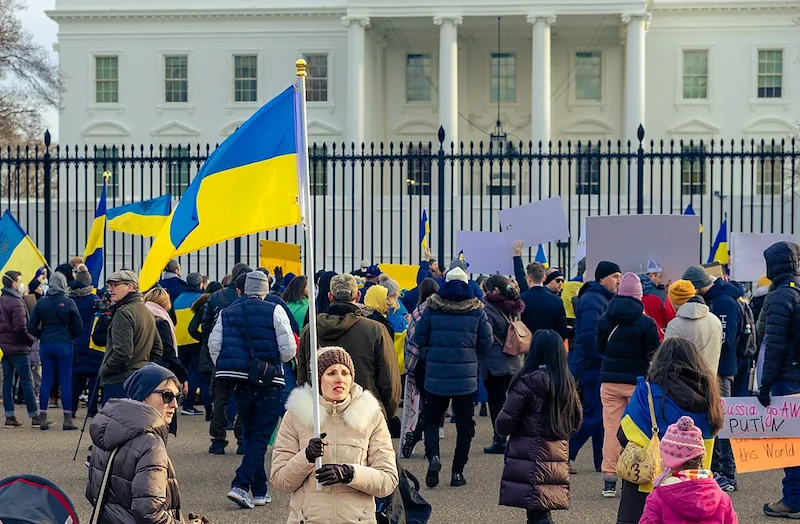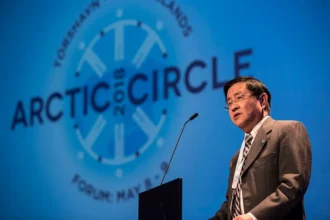The Trump Administration has taken aim at a variety of programs previously designed to facilitate the movement of people across borders to the United States. Perhaps most alarmingly, they have also gone after the most vulnerable category of people: refugees fleeing war and violence. After gutting USAID and other aid programs targeted at underserved communities globally, they have switched their focus to international underserved communities here in the US.
When the Russian full-scale invasion of Ukraine occurred on February 24, 2022, thus escalating the Russo-Ukrainian War into a full-scale conflict, Europe and the West were presented with the largest refugee crisis on the continent since the Second World War. Leaders in Europe and the United States had to develop how they would facilitate the safe passage of what would eventually amount to nearly seven million people from the war zone into safe nations.
When humanitarian programs are built on temporary politics rather than principled commitments, protection itself becomes precarious.
The European Union, drawing on protocols that date back to the days of the Balkan Wars in the 1990’s and the resulting wave of refugees, has been largely successful in taking these people. The United States as well has been committed to refugee protection in tandem with their European counterparts. That is, until the second Trump Administration.
From Open Arms to Closed Channels
But what does the uncertain future of Ukrainian refugees in the U.S. reveal about the political fragility of humanitarian protection? This article explores how recent policy shifts suggest that the welcoming stance toward Ukrainians was never fully decoupled from electoral incentives, foreign policy optics, and racialized hierarchies. Ukrainians fleeing violence in their home country by coming to the United States number nearly 300,000.
They receive protection under a few different programs funded and administrated by the US government (as well as miscellaneous private organizations, which while not being the subject of this article are important and do meaningful work in this field). The two main programs by which people from Ukraine receive humanitarian protections in the United States are via the Temporary Protected Status and the Department of Homeland Security’s Uniting for Ukraine humanitarian parole program.
The Trump Administration has thus far spared Ukraine in its abrasive media campaign smearing refugees and other humanitarian migrants (primarily those from Latin America, such as Venezuelans). This does not, however, mean that Ukrainians are safe.
Uniting for Ukraine: A Program at Risk
The Uniting for Ukraine (U4U) program began on April 11, 2022, about a month after the full-scale Russian invasion of the country. The Biden Administration immediately understood the necessity of such a program designed specifically for people fleeing a conflict of this scale. It has since helped over 100,000 people flee Ukraine for the United States.
Uniting for Ukraine operates within the humanitarian parole system, a program which serves thousands more from many different countries ranging from Ethiopia to Haiti. In order to gain protections under Uniting for Ukraine and in turn the humanitarian parole apparatus, applicants must submit a USCIS form known as Form 134.
The Trump Administration indefinitely suspended the filing of this form with the signage of the Secure Our Borders executive order on January 19, 2025. Since then, no new applicants to the Uniting for Ukraine or any other DHS humanitarian parole program which requires screening via Form 134 have been accepted. While those already protected under the Uniting for Ukraine program can still file a separate form to extend their protections (as the initial program was only for two years), potentially thousands of people are still left behind without any way to receive these protections.
Mixed Signals and Political Uncertainty
Even those already under these protections, however, have cause for concern. On April 3, 2025, the Department of Homeland security sent out a mass email to “some” people receiving protections under Uniting for Ukraine.
The email demanded that they leave the United States “within seven days” and encouraged them to self-deport. The email was later apologized for by a DHS spokesperson, who in a statement claimed the emails were erroneously sent. The DHS has further clarified that they currently have no intention of deporting these people currently receiving protections. The reason why is unclear, but it of course could indicate that a plan to deport these persons is in the works.
The Temporary Protection Status (TPS) program has also been the target of Trump Administration. Just prior to leaving office in January 2025, then-Secretary of Homeland Security Alejandro N. Mayorkas announced the continued protection of Ukrainians under the Temporary Protection Status program for an additional 18 months, from April 2025 to October 2026. While the focus for deportations of people protected under TPS has largely seemed to be those from Venezuela, the future remains uncertain for the 50,000 Ukrainians protected under the program.
Ukrainian Refugees : A Temporary Welcome—and Its Human Cost
In our research interviewing Ukrainian refugees and migrants in the Washington DC metropolitan region, we have found our participants to be highly educated. Most people we have spoken with have a master’s degree, or two, and many more have doctorates or other certifications. Many have been educated in the United States and Western Europe, and they seem to see the United States as a key part of the support for their embattled nation.
A woman we interviewed remarked: “When people hear that we are from Ukraine, they want to help because they know about the situation in our country.” Another woman reflected on her “breaking point when a missile hit 500 meters from my house.” Ukrainians need US support as much now as they ever have.
Many thousands more people may be in similar situations as this woman today. But if this same woman still had missiles landing in her neighborhood, she would be unable to apply for the Uniting for Ukraine program or other humanitarian protections to be able to stay in the country legally.
The story of Ukrainians in the United States—welcomed one year, uncertain the next—points to a broader truth: when humanitarian programs are built on temporary politics rather than principled commitments, protection itself becomes precarious. In this light, the question is not just whether Ukrainian refugees are still welcome—but whether America’s compassion can survive its electoral cycles.









